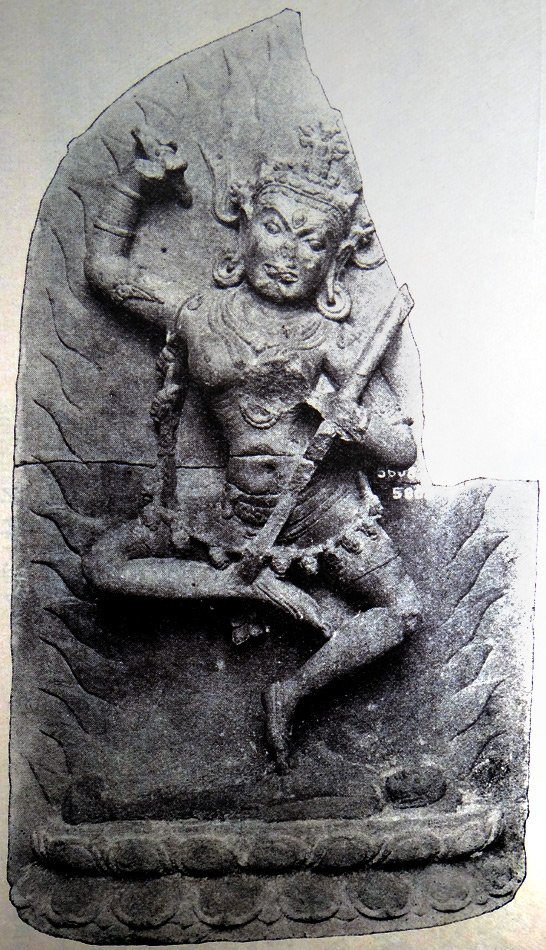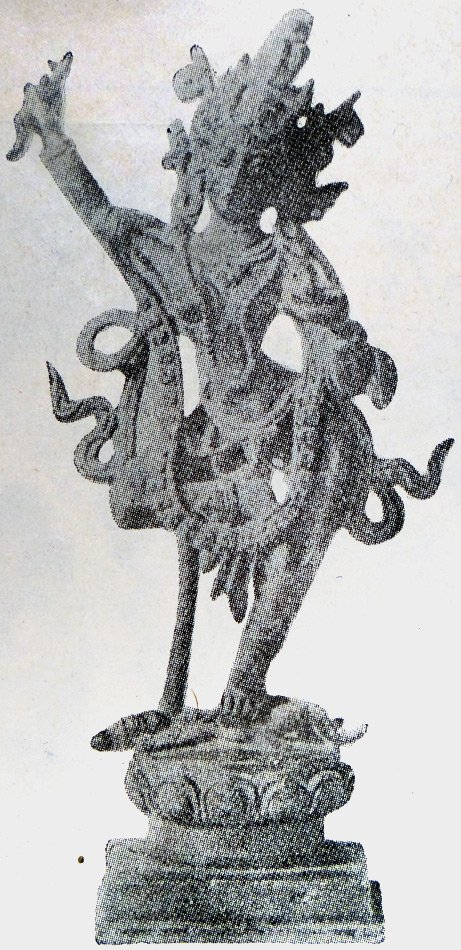The Indian Buddhist Iconography
by Benoytosh Bhattachacharyya | 1958 | 51,392 words | ISBN-10: 8173053138 | ISBN-13: 9788173053139
This page contains an iconography image of Emanations of Akshobhya: Nairatma and represents figure 148-149 of the book Indian Buddhist Iconography, based on extracts of the Sadhanamala English translation. These plates and illustrations represent either photographs of sculptures or line-drawing reproductions of paintings or other representations of Buddhist artwork.
Figure 148-149 - Emanations of Akṣobhya: Nairātmā
 Figure 148: Nairātmā (Indian Museum) |
 Figure 149: Nairātmā (Vaṅgīya Sāhitya Pariṣat) |
Āsana: dancing in ardhaparyaṅka;
Colour: blue;
Appearance: terrible;
Vāhana: corpse lying on its back;
Symbols: kartri and kapāla.
Two Sādhanas in the Sādhanamālā describe her form, which is in many respects, similar to the form of Vajravārāhī with the Kartri and the Kapāla, the principal point of difference being the position of the corpse which forms their Vāhana, When it lies on its chest it is Vajravārāhī, but if it lies on its back the goddess is Nairātmā. There are other distinguishing features also For instance, Vajravārāhī being an emanation of Vairocana, should bear the image of Vairocana on the crown ; while Nairātmā, being an emanation of Akṣobhya, should bear the image of Akṣobhya instead. Moreover, the excrescence near the the right ear of Vajravārāhī must be absent in the case of Nairātmā. In all other respects there is a remarkable resemblance between the two.
The word ‘Nairātmā’ means ‘no-soul’ and is another name for Sūnya, in which the Bodhisattva merges on the attainment of Nirvāṇa. Gradually, the conception of Sūnya took the form of a goddess in whose embrace the Bodhisattva is said to remain in eternal bliss and happiness, Nairātmā gets the blue colour, because the colour of Sūnya according to the Buddhist tradition, is like the colour of the sky, which is blue.
The Indian Museum image No. 3941 (Fig. 148) is the only image of this goddess which conforms to the description given in the Sādhana just quoted. Here the goddess, in accordance with the Dhyāna, has a terrible appearance with canine teeth, garland of heads and three eyes rolling in anger. She stands on the corpse lying on its back, and dances in the Ardhaparyaṅka attitude. Burning flames radiate from her person, and her hair rise upwards in the shape of a flame. She is decked in the five auspicious symbols, the Kaṇṭhikā (torque), Rucaka (bracelets), Ratna (jewels), Mekhalā (girdle), and Bhasma (ashes) or the Sūtra (sacred thread) in the form of a garland of heads. She bears the image of her sire Akṣobhya on her crown and carries the menacing Kartri in the right hand. The left hand holding the Kapāla is broken. The Khaṭvaṅga, as usual, hangs from her left shoulder.
The Vaṅgīya Sāhitya Pariṣat bronze (Fig. 149) shows the above characteristics, but the Khaṭvaṅga is lost. It is lost in the same way as small weapons in Nepalese and Tibetan bronzes are often found missing. Nairātmā is popular in China.
